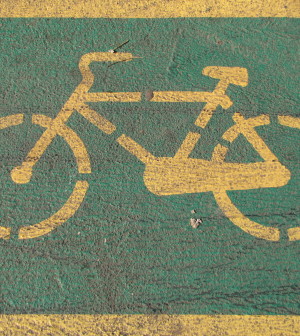- Double Mastectomy May Offer No Survival Benefit to Women With Breast Cancer
- Toxic Lead Found in Cinnamon Product, FDA Says
- Certain Abbott Blood Sugar Monitors May Give Incorrect Readings
- Athletes Can Expect High Ozone, Pollen Counts for Paris Olympics
- Fake Oxycontin Pills Widespread and Potentially Deadly: Report
- Shingles Vaccine Could Lower Dementia Risk
- Your Odds for Accidental Gun Death Rise Greatly in Certain States
- Kids From Poorer Families Less Likely to Survive Cancer
- Tough Workouts Won’t Trigger Cardiac Arrest in Folks With Long QT Syndrome
- At-Home Colon Cancer Test Can Save Lives
For Teens, Favorite Tunes May Impair Driving


FRIDAY, Aug. 30Music may soothe the savage beast, but a new study argues that novice teenage drivers who rock out to a playlist of favorite tunes may end up with impaired motor skills.
Active listening — humming along with, tapping out the beat of or otherwise getting absorbed by tracks youthful drivers know and like — appears to distract them from the rules of the road, researchers report.
The result is an increase in error-prone behaviors, such as speeding, tailgating and one-handed steering, as well as aggressive and distracted lane-switching and passing.
On the other hand, the Israeli investigators said, certain types of music can actually promote safe teen driving, when comprised of less familiar, calming compositions.
“The car is the only place — the only audio-related acoustic environment — [in which] listening to music can be fatal,” said study co-author Warren Brodsky, director of music science research in the department of the arts at Ben-Gurion University of the Negev in Beer-Sheva, Israel.
“So the message has to be learn to choose music more appropriately,” Brodsky said. “And if or when circumstances are more risky — such as being tired, at night time, in highly congested traffic, after party duress, or [when a driver is] a bit tipsy or very emotional — there might be music that could increase safety and lower risk factors for the … ride home.”
Brodsky joined his BGU colleague Zack Slor to discuss their research, funded by the Israel National Road Safety Authority, in the October issue of the journal Accident Analysis and Prevention.
The study comes on the heels of recent Dutch research, in which Ayca Berfu Unal, of the University of Groningen, found that the driving abilities of young people were not negatively impacted by listening to music of their choosing. That research, however, was a conducted using a virtual road simulation test and involved university students between the ages of 19 and 25 with an average of two and a half years of driving experience.
By contrast, Brodsky and Slor focused on the real-world road experience of 85 new Israeli drivers between the ages of 17 and 18, all of whom had procured their licenses an average of only seven months prior to the study launch. Roughly 60 percent were male.
None of the participants had been to traffic court, and only 8 percent had ever been involved in a collision.
Music, the authors said, was a near-ubiquitous feature of the driving experience, with 86 percent saying they listened to music all the time when behind the wheel. Pretty much all (99 percent) described that music as “moderately fast or very fast,” and nearly as many (94 percent) said they played it on the loud end of the scale.
All the teens were paired with one of two expert driving instructors, with whom they embarked on a series of six challenging 40-minute, 25-mile road trips, under three different conditions: two trips while playing their own music, two trips while playing author-supplied music and two trips with no music.
The participants’ preferred music included an average of 12 songs taken from each driver’s personal collection. About two-thirds were international tracks, while a third were Israeli tunes.
By contrast, the 30-minute “alternate” music collection (selected by Brodsky and Israeli composer Micha Kisner) included eight tracks of unfamiliar non-vocal tunes from the genres of easy listening, soft rock or light jazz, with a focus on lush harmonies and relatively modest rhythms, tempos, timbres, voice textures and instrumental arrangements.
In-vehicle data-recording devices and driving instructor observations revealed that while listening to their preferred music, 98 percent of the teens displayed (on at least one of the two trips) three or more driving deficiencies. Deficiencies included driving aggressively or inaccurately, miscalculating and committing a traffic violation.
Nearly one-third of the preferred trips required an instructor to yell out a sudden verbal warning or command, while one-fifth needed their assistance to steer or brake in order to prevent an accident.
On the no-music trips 92 percent of the teens also made similar errors.
The team found, however, that when teens drove with the calming alternate soundtrack in the background their deficient driving behaviors fell by 20 percent.
But will teen drivers turn down the volume on music they like? Brodsky pointed to the slow but steady acceptance of seatbelts and condoms, suggesting that this too “is an issue of awareness and changing attitudes.”
“The car is not a dance floor, nor a karaoke bar, a sports facility or exercise class,” he said, adding that “the music chosen to listen to should be more adaptive to the environment.”
Although the U.S. National Highway and Transportation Safety Administration deems “adjusting a radio, CD player or MP3 player” to be a distraction that “could divert a person’s attention away from the primary task of driving,” it has not specifically studied how music itself might distract drivers.
The NHTSA, however, did point out that in 2011 more than 390,000 Americans were involved in a crash with a distracted driver, and that the under-20 set is the age group with the largest proportion of distracted drivers.
More information
For more on distracted driving concerns, visit the U.S. National Highway Traffic Safety Administration.
Source: HealthDay
Copyright © 2024 HealthDay. All rights reserved.










